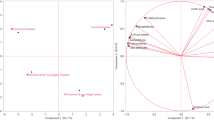Abstract
Robusta coffee beans were roasted by three methods, i.e. convectively at 230 °C, by microwaves at 700 W, and by the coupled convective–microwave (CMR) method (the simultaneous convective heating at 230 °C and microwaving at 700 W) for 590, 670, and 370 s, respectively. The ultimate temperature of roasted beans was 238, 207, and 228 °C, respectively. Volatile compounds were determined in the headspace by GC-SPME both in samples of roasted coffee and in green beans to find effects of roasting methods on their formation and retention. Eighty-two and 148 odorants were identified in green and roasted coffee, respectively. The highest contents of the latter were found in coffee roasted by the coupled method because both the relatively short time of roasting and moderately high final temperature of beans favored retention of volatile aroma compounds. Because of these reasons, the contents of odorants were the lowest in convectively roasted coffee.

Similar content being viewed by others
References
Sarrazin C, Le Quéré J-L, Gretsch C, Liardon R (2000) Food Chem 70:99–106
Sanz C, Czerny M, Cid C, Schieberle P (2002) Eur Food Res Technol 214:299–302
Czerny M, Mayer F, Grosch W (1999) J Agric Food Chem 47:695–699
Meyer F, Czerny M, Grosch W (1999) Eur Food Res Technol 209:242–250
Schröder I, Stern G, Hojabr-Kalali K, Schliekelmann K, Maier HG (1999) Dutsch Leb-Rundsch 93:216–218
Jensen MR, Kirkpatrick SJ, Leppla JK (1994) US Patent, 5,333,703
Sivetz M (1991) ASIC 14th Colloque, San Francisco 313–317
Le Viet T, Truchement B (1988) CH Patent, 665 754 A5
Gerling JF (1984) US Patent, 4,326,114
Nebesny E, Budryn G (2006) Eur Food Res Technol, online publication http://dx.doi.org/10.1007/s00217-006-0308-y
Nebesny E, Budryn G (2003) Eur Food Res Technol 217:157–163
Nebesny E, Budryn G (2006) Deut Lebensm–Rundsch, in press
ISO 10470 (1993)
ISO 4149 (1980)
Sanz C, Ansorena D, Bello J, Cid C (2001) J Agric Food Chem 49:1364–1369
Lewandowicz G, Jankowski G, Fornal J (2000) Carbohyd Polym 42:193–199
Friedman M, Dao L (1990) J Agric Food Chem 38:805–808
Clarke RJ (1990) Ital J Food Sci 2:79–88
Mayer F, Grosch W (2001) Flavour Fragr J 16:180–190
Lee K-G, Shibamoto T (2002) Flavour Fragr J 17:349–351
Ramos E, Valero E, Ibáňez E, Reglero G, Tabera J (1998) J Agric Food Chem 46:4011–4016
Bicchi CP, Panero OM, Pellegrino GM, Vanni AC (1997) J Agric Food Chem 45:4680–4686
Hashim L, Chaveron H (1996) Food Res Int 28:619–623
Belitz HD, Grosch W (1999) Food chemistry. Springer-Verlag, Berlin, Hilderberg, p 322
Jung MY, Bock JY, Back SO, Lee TK, Kim JH (1997) Food Chem 60:95–102
Czerny M, Wagner R, Grosch W (1996) J Agric Food Chem 44:3268–3272
Blank I, Sen A, Grosch W (1991) ASIC 14th Colloque, San Francisco 117–128
Boosfeld J, Vitzthum OG (1995) J Food Sci 60:1092–1096
Spadone JC, Takeoka G, Liardon R (1990) J Agric Food Chem 38:226–233
Belitz HD, Grosch W (1999) Food chemistry. Springer-Verlag, Berlin, Hilderberg, pp 344–346
Hida Y, Matsumoto M, Kudo K, Imamura T, Ikeda N (1997) Int J Legal Med 111:13–16
Nijhuis HH, Torringa HM, Muresan S, Yuksel D, Leguit C, Kloek W (1998) Trends Food Sci Technol 9:13–20
Yoshida H, Kajimoto G (1989) J Food Sci 54:1596--1600
Author information
Authors and Affiliations
Corresponding author
Rights and permissions
About this article
Cite this article
Nebesny, E., Budryn, G., Kula, J. et al. The effect of roasting method on headspace composition of robusta coffee bean aroma. Eur Food Res Technol 225, 9–19 (2007). https://doi.org/10.1007/s00217-006-0375-0
Received:
Revised:
Accepted:
Published:
Issue Date:
DOI: https://doi.org/10.1007/s00217-006-0375-0




